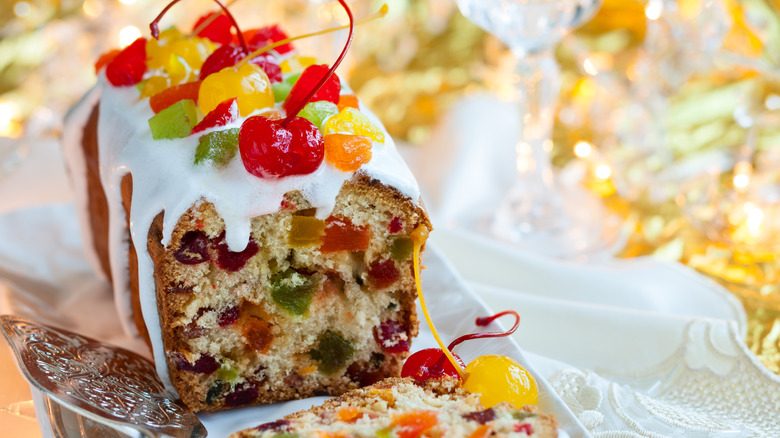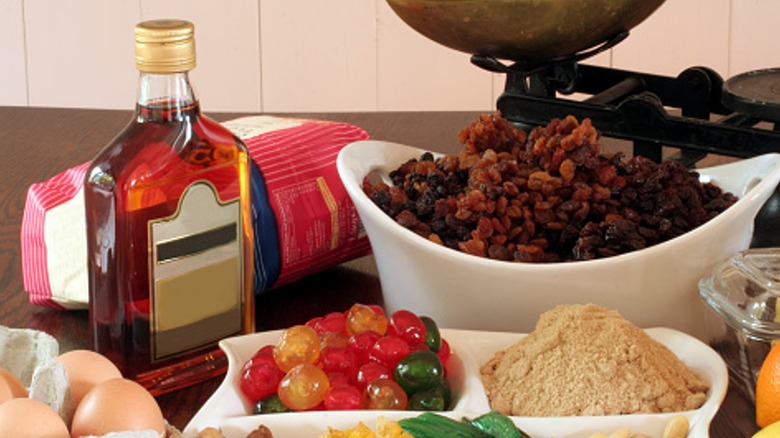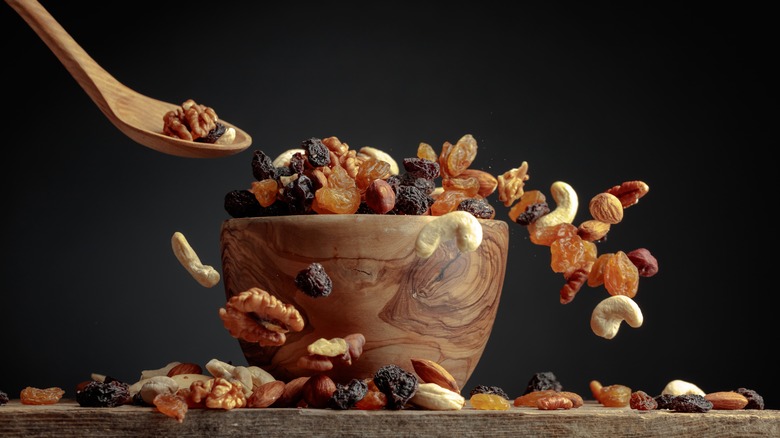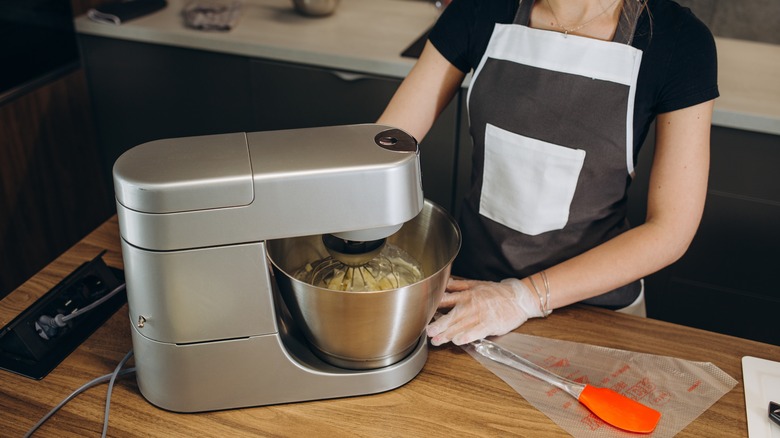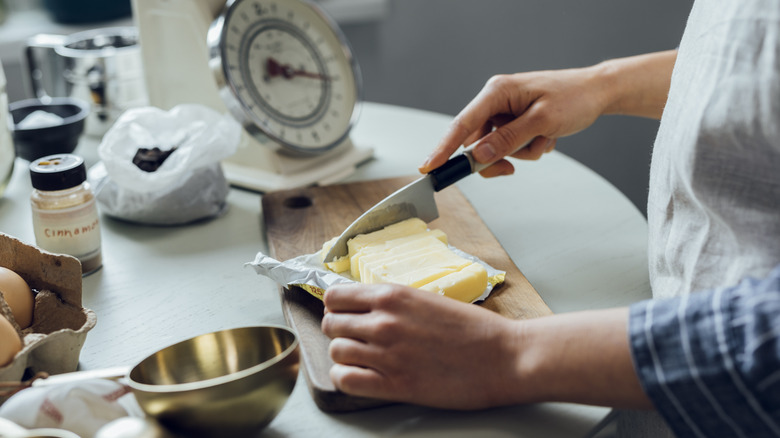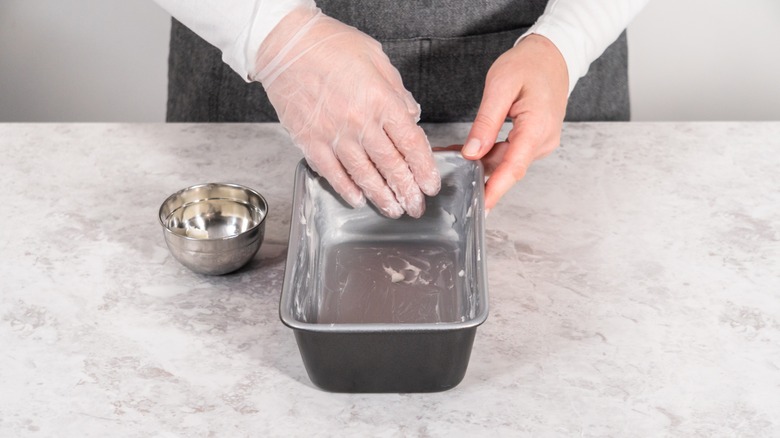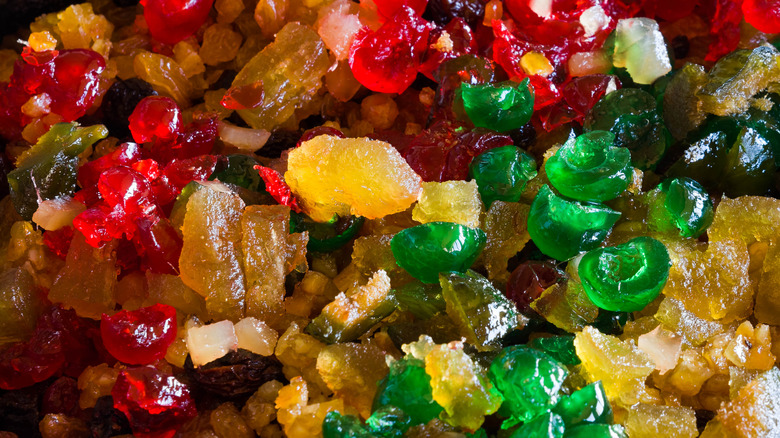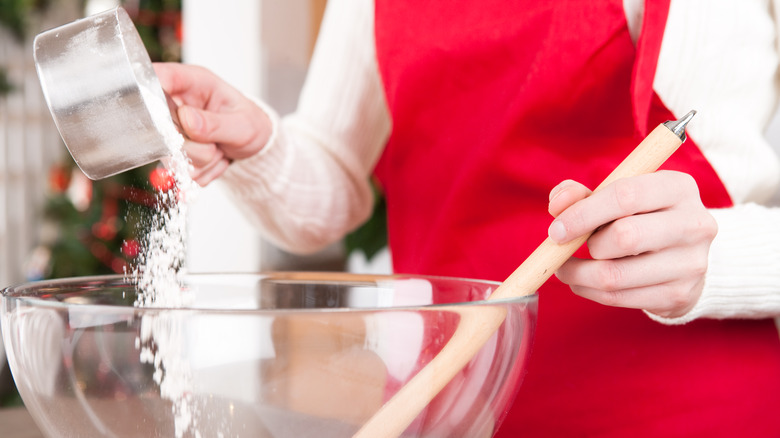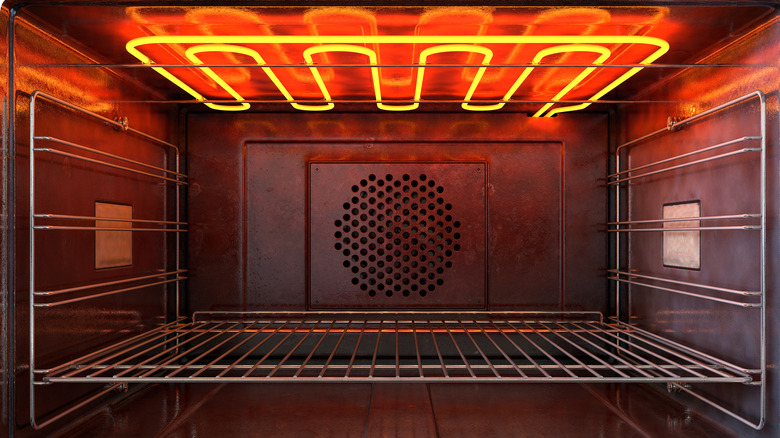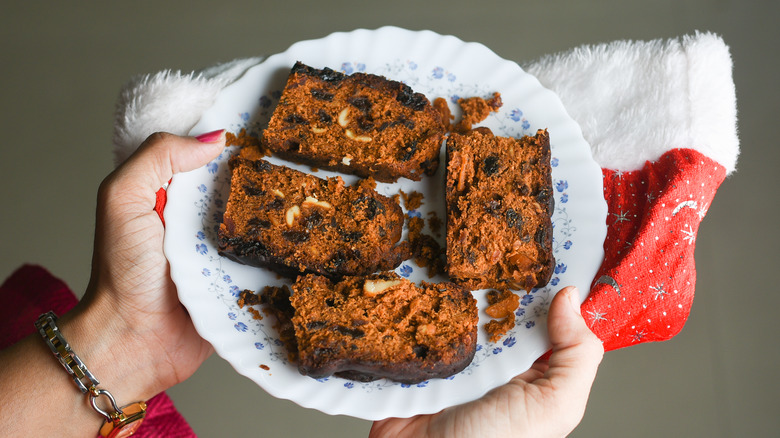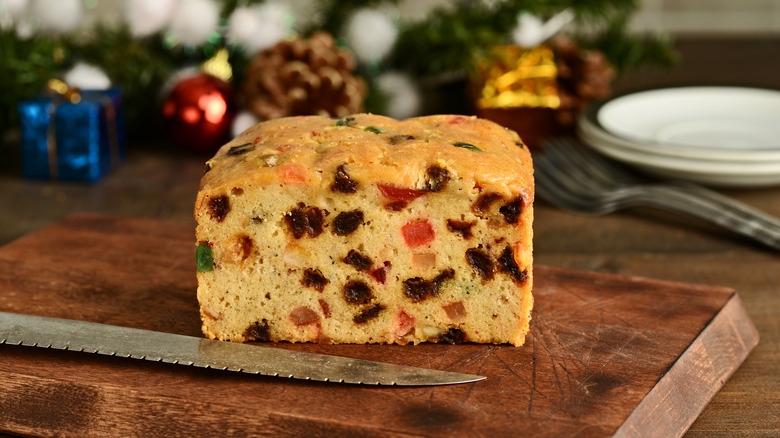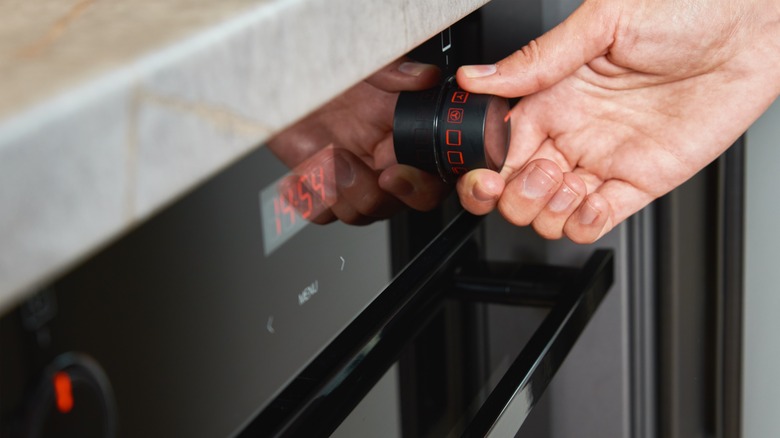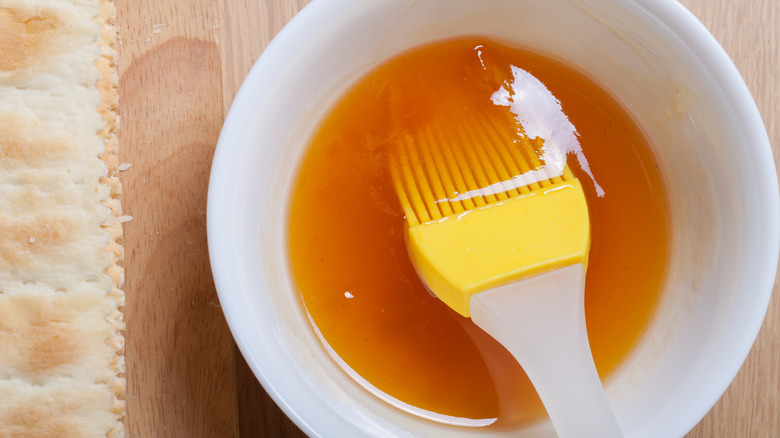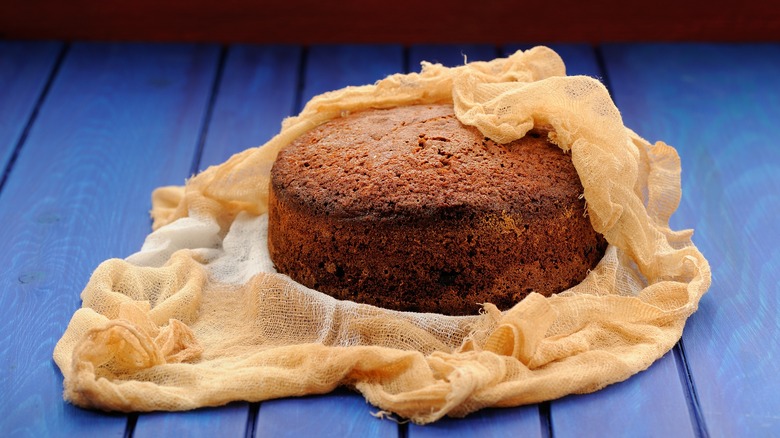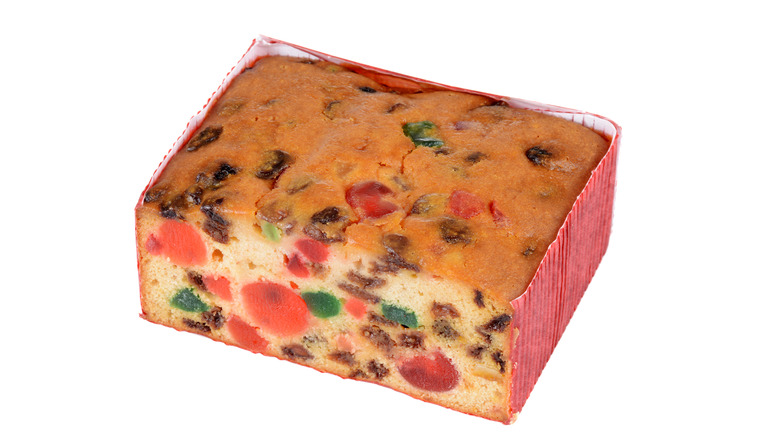14 Common Mistakes Everyone Makes When Baking Fruitcake
Have you ever considered that you've only experienced horrible fruitcake because somebody didn't know what they were doing when they made it? Although fruitcake often gets a bad reputation, it's usually due to improper preparation, resulting in a bland, dry, or overly dense cake. Moreover, maybe the ingredients used aren't the best, or the aging process didn't go smoothly. To be fair, making a marvelous fruitcake isn't as simple as making a loaf of banana bread.
So, for home bakers who suddenly feel the urge to take on a project of this size without prior knowledge, it's understandable how their fruitcakes seem to lack a wow factor. However, when done correctly, what seems like a meticulous process becomes enjoyable. The first step to success is knowing the most common mistakes that everyone makes so that you don't make them yourself. Fortunately, after reading on, you'll understand the important details so you can make a fruitcake that's moist and decadent beyond belief.
1. Choosing low-quality ingredients
At the base of every deliciously made fruitcake is a foundation of good-quality ingredients. You won't have the best outcome if you throw together a fruitcake at the last minute with old baking ingredients. The longer that dried fruit sits untouched, it begins to lose flavor and doesn't have the freshest texture. Of course, since fruit is the primary component of the sweet treat, it's a good idea to examine its quality before you use it. You can purchase the dried fruits from a locally owned shop or at least a store that has a consistent turnaround on their product, guaranteeing that it's fresh.
Moreover, the same applies to any nuts you use; double-check to ensure they're not stale or rancid. Regarding the other baking ingredients, check the best-by dates on your leavening agents. You might not know, but these products lose their effectiveness over time, so the bread doesn't get the right amount of lift if you use old products. Lastly, instead of using that old jar of ground cinnamon (or any other spice, for that matter) that's been in your pantry, consider buying fresh and grinding it yourself. Freshly ground spices are more robust and give the fruitcake a complex flavor.
2. Failing to prepare the mix-ins
Some people bypass a couple of steps concerning fruitcake mix-ins. First, if you don't soak the fruit, they turn into dry pellets in the baked good, having an unpleasant consistency. Also, the fruit absorbs moisture from the batter while it bakes if you don't correctly hydrate it beforehand. So, although it might seem like a hassle to plan ahead and moisten them, it is assuredly worth it. Soak them for at least two or three days prior for best results, but a week is optimal if you have the time.
Use rum or whichever liquor you prefer, or take a different approach and use another liquid. For instance, orange juice or even apple cider are good options. For alcohol-soaked fruit, keeping it at room temperature is fine, but for fruit juice that's normally refrigerated, you can keep it in the cooler. Place the dried fruit in a mason jar or container and pour the liquid on top until it covers it entirely.
Put an airtight lid on the mixture, and every day or so, shake it to ensure everything gets thoroughly moistened. Hydrating the nuts is more optional; some folks prefer their crunch and would rather not soak them, but you certainly can. Another mistake you want to avoid with the mix-ins is throwing them in the batter without coating them in flour first. Unfortunately, when you do this, they all sink to the bottom, which ruins the presentation of the baked good.
3. Overmixing the batter
Mixing your fruitcake batter for too long can cause several issues, including structural or presentation problems. First, the fruitcake turns tough when it bakes. Although this type of cake is supposed to be somewhat dense, it shouldn't be difficult to chew. Furthermore, if you overmix the batter, it can cause the baked good to be crumbly, which is quite noticeable when you slice and serve it.
These issues arise when you agitate the flour in the mixture too much. The protein strands create gluten that gets overdeveloped, which makes the dough tight. Another telltale sign that you overmixed cake batter is that the cake deflates or cracks when you remove it from the oven. This means you whipped too much unnecessary air into the mixture, making the fruitcake rise too much, so it overexpands and then falls. With this type of sweet treat, you only need to add the final additions and then gently fold the components until everything comes together.
4. Using butter instead of oil
Believe it or not, one mistake people make is using butter in the batter rather than oil. You might think that butter is better because, after all, it does have a much richer flavor. But the real kicker is that butter produces a less tender bake than oil. In a dessert like fruitcake with aromatic spices and flavorful fruit and nuts, you don't necessarily need the butter's flavor, so you should go for the product that produces the best cake crumb.
Vegetable oil remains a liquid at room temperature, whereas butter doesn't. Consequently, when you use butter for cakes, it solidifies again after baking. Therefore, if you use vegetable or canola oil, the fruitcake has a moister mouthfeel. Although some other cakes don't have as much going on flavor-wise and need that deep buttery taste, we promise that it doesn't provide much flavor for fruitcake and won't be missed.
5. Not greasing and lining the pan
Unfortunately, some home bakers fail to adequately grease or line the pan, which makes it challenging to release the cake from the mold. It's typically easy to loosen the sides with a knife, but if the bottom is stuck, there's a chance that the fruitcake breaks if you have to use a lot of force to remove it. However, with the proper precautionary measures, you don't have to worry about flipping the fruitcake out only to see that some of it is still intact in the baking dish.
With this type of baked good, you can first grease the dish with oil, butter, or cooking spray. However, it would be best if you didn't stop there. Lining it with parchment paper afterward is undoubtedly the way to go. You can even put two layers of parchment, which helps prevent the sides from getting too dark too soon. Also, if you wish, leave a slight overhang of parchment to make it easier on yourself later. You can grab it like a sling and lift the fruitcake out right side up instead of having to flip it upside down.
6. Only using fruitcake mix
Sometimes, people make the mistake of only using pre-made fruitcake mix, leading to a mediocre fruitcake. Perhaps some people feel inclined to stick to the traditional fruit mixture or they simply find it easier. There's no denying it's less effort, especially since the fruit is usually pre-chopped to the correct size. Nevertheless, the store-bought mixes are sometimes anything but fruit — they taste overly artificial and have tons of preservatives and unnatural colors.
Don't feel like you have to use the classic combination of candied cherries, pineapple, and citrus peels if you don't like it. You are free to create your own fruit blend with different types you actually enjoy. Even if you include some less common choices, it can enhance the flavor and improve the recipe. Another option is to stay loyal to the conventional blend but simply candy and chop them yourself, making them taste fresher and less artificial. This step is one way to make a holiday fruitcake people will actually love.
7. Being careless when measuring ingredients
If you've ever had a fruitcake with an off taste or texture, the ingredients may have been incorrectly measured. Sadly, when you rush and don't precisely measure components like flour, sugar, and leavening agents, it negatively affects the quality of the baked goods. It might make the fruitcake taste poorly or not rise correctly. For example, rather than sticking the measuring cup into a bag of flour and packing it, you can use a spoon to fill the cup instead. Then, use a knife or another flat tool to level it, which gives you exactly one cup.
Additionally, make sure to keep the proportions the same if you swap or adjust certain mix-ins. Not everyone enjoys nuts in their fruitcake, but if you simply omit them from the recipe without replacing them with dried fruit or something else, it can cause problems with the final product. Also, if you end up coating the fruit in flour, you must use a portion of the pre-measured flour. Don't make the mistake of adding more flour to the recipe because it can lead to texture problems when it bakes.
8. Baking it in a dry oven
Unfortunately, this sweet treat bakes longer than others, so it tends to dry out in certain ovens. You might be unfamiliar with the practice, but professional bakers often take a particular step to prevent certain pastries and bread from becoming dry, and you can do it too. Simply introduce some moisture to the environment by manually adding water to the oven. When the fruitcake bakes, it absorbs the excess moisture in the air and ends up with a much more pleasant mouthfeel.
Before you put your fruitcake inside, place a tray or pan at the bottom of the chamber. Then, carefully pour hot (or at least lukewarm) water into the pan. When you fill the baking dish, be mindful of leaving enough space for easy removal without spilling, which can be dangerous because the water will be piping hot. However, remember to put enough so it doesn't all evaporate during baking, leaving the tray completely exposed to the heat.
9. Under or overbaking it
Although recipes are helpful guidelines for how long to keep the fruitcake in the oven, some might use that as the only frame of reference. If you pull it from the oven without checking that it's baked to the right texture and color, you might end up with an under or overbaked cake. Underbaked cakes sometimes appear done on the outside, but they have a gummy texture when you cut into them. Or they might also be overly sticky or soggy when you unmold them from the pan. On the flip side, overbaked cakes have too dark of a color on the outside, and their internal texture lacks moisture.
To ensure you don't lose all your hard work, use a toothpick or knife and insert it into the center part of the baked good, examining to see if it comes out clean. If the batter comes up with the toothpick, you must continue to bake it longer. Sometimes, the fruitcake is dark enough on top, but it still needs to bake through; cover it with foil and return it to the oven to prevent burning on the surface. Meanwhile, a clean toothpick indicates that you should remove the baked good from the oven.
10. Serving it immediately
Part of the magic of fruitcake is that it tastes better when it ages, which makes this baked good unique and sets it apart from other types of bakes. Yet, some people wait too long to begin preparation, which is a huge error because it requires careful planning. If you have to rush the process, you miss out on dimensions of flavor that only arise from thoughtfully soaking the fruit and allowing the cake to rest for days or weeks after baking.
Although you can only soak the fruit overnight, bake the fruitcake, and serve it immediately, it doesn't compare to the mouthwatering taste and texture that you receive from a cake you prepare with patience and care. Planning is crucial when it comes to making fruitcakes. Allow enough time for the fruitcake to mature, and you will be rewarded with an impeccable experience when you finally enjoy it.
11. Baking it at too high of a temperature
Since this type of batter is so heavy, it takes time to cook in the center. Therefore, it causes problems when people crank the oven heat and try to bake it at higher temperatures. This practice is a surefire way to make the outside of the cake overdone while the inside is still raw. This issue is challenging to come back from because it makes the exterior like a hard shell that's not appetizing. Even if you try to rescue it by lowering the oven and covering it with foil, the damage is likely already done.
The only way to guarantee the center cooks is to bake it slowly. At maximum, the highest temperature to use is 325 degrees Fahrenheit. Some experienced bakers use lower temperatures, such as 275 or 300 F, with a longer baker time. It comes out much better overall if you cook the fruitcake in this range.
12. Not using syrup after baking
The step you can't skip when you make fruitcake is brushing it with some syrup while it is still warm. Yes, even if you plan to mature the cake over time, this is still a must. You see, there is a golden window when the cake is fresh out of the oven. The crumb absorbs liquid much more effortlessly while warm compared to when cooled. To do so, you'll need to make a simple syrup on the stovetop.
You can make it incredibly basic by using half sugar and half water. Cook it in a pan until it thoroughly heats and the sugar dissolves. However, you can also take it up another level by customizing it. Namely, you can add alcohol, citrus juice, or even allow spices to steep in the syrup while it cooks to impart more flavor to the baked good. Most importantly, when you do this, it prevents the cake from lacking moisture.
13. Not knowing the proper way to age it
Once you properly prepare the mix-ins and bake the fruitcake, the aging process is the next step that you don't want to fumble. If you do this step incorrectly, the baked good takes on a stale and brittle texture. When you age it, also called seasoning or maturing, you introduce moisture and add flavor to the fruitcake with alcohol. First, dampen a cheesecloth with rum, brandy, or another preferred liquor and wrap it around the cake multiple times (all of the alcohol absorbs into the cake over time).
Then, cover it with a few layers of plastic wrap. If you want to be extra careful, you can also use foil after that, followed by putting it in an airtight container. Next, which is arguably the most crucial part of maturing a fruitcake, is "feeding" it periodically with more alcohol, which gives it a more complex flavor and softer consistency. Once a week, either add more alcohol by brushing it evenly on the fruitcake or by soaking the cheesecloth again and re-wrapping it. You can age it for however long you want, whether it be for a few weeks or a few months.
14. Improperly storing it
Keeping a fruitcake fresh isn't as straightforward as other bakes like cookies or brownies. If you don't store it correctly during the maturing process and after it is ready, you might accidentally make it slimy, stale, or go bad prematurely. First, you can't wrap it while it is still warm because it creates condensation beneath the plastic wrap or whatever you use to cover it. In turn, the outer layer of the dessert becomes sticky or wet. Additionally, some people might make the mistake of storing it in the refrigerator while they age it. However, refrigerating fruitcakes at this point is unnecessary as it hardens the cake and prevents the alcohol and fruit flavors from melding together.
The U.S. Department of Agriculture (USDA) states that you can safely keep ready-to-eat fruitcake at room temperature for one month, in the refrigerator for six months, or in the freezer for one year. This is why fruitcake is such a good option for holiday gift-giving because you can safely ship it to loved ones in other states as soon as it's ready, and you don't have to worry about it turning moldy without refrigeration along the way. Either way, when you store or ship it, tightly wrap it with multiple layers of plastic wrap to fully enclose it and prevent air from coming into contact with it.
